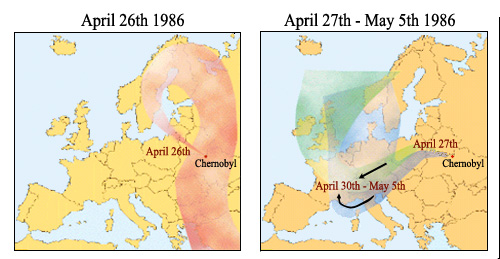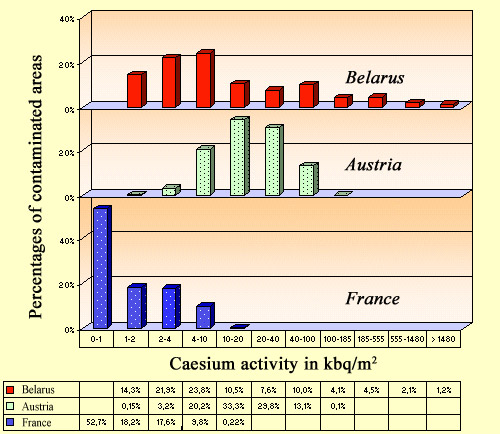Radioactive releases and contaminations at Chernobyl

Path of Chernobyl releases
The path of the radioactive plume has been reconstructed with data collected from European countries. Much of the released radioactivity was emitted on April 26th, 1986, which, after heading toward the Scandinavian countries, fall back toward the east and south. Releases afer April 27th, driven westward, reach France by its eastern and southeastern borders. The radioactive plume crossed the territory between April 30 th and May 5th. Releases issued after April 27th contaminated essentially the eastern and southern parts of Europe.
© IRSN
The explosion of the reactor led to the dispersal of many radioactive elements. In total, the activity released, during the 10 first days in the environment, is estimated to be around 12 billion GBq (gigaBecquerels). The radioactive plume, driven by air masses up to 10 000 meters and then drifting with the winds, has spread, over most countries in Europe, radionuclides such as iodine-131, caesium-134 and 137. Because of its short half-life (8 days), iodine-131 has quickly vanished. Today, one finds mainly the remaining activity due to caesium-137.
Numerous measurements have allowed to reconstruct the map of ground contamination at the time of the accident. A good standard of this contamination is the activity of caesium-137, expressed in kilobecquerels (kBq) per square meter. Caesium-137 is a relevant radionuclide because it is still present today and easy to detect.

Contaminated surfaces
The surface distribution of the ground contamination level (expressed in kilobecquerels of cesium-137 per square meter) varies greatly from one part of Europe to another. In France, over 52% of the country received less than 1 kBq/m2 and contaminations above 10 kBq / m 2 were exception. In Austria contaminations were much higher because of topography and rainfalls. An extreme case was Belarus, highly exposed because of its proximity to Chernobyl.
© IN2P3 (Source Atlas de Tchernobyl)
About 45% of the caesium released by the explosion was deposited in states of the former USSR. Belarus was the most affected: more than 23% of the land was contaminated: it received more than 37 kBq/m2. Some regions have even registered more than 1500 kBq/m2. In Western Europe, it was in Austria, Germany, Italy and Scandinavia where measured deposits were the highest (some kBq/m2).
In France, the largest deposits in the east of the country have not exceeded 6 kBq/m2 while it remained below 750 Bq/m2 in the west of the country.
These deposits are distributed very unevenly like the spots of a « leopard skin ». « Peaks » of radioactive deposits (a few tens of caesium-137 kBq/m2) were observed locally in France because of the influence of rainfall and relief. For example, the passage of contaminated air masses over the Alps during an episode of heavy rainfall resulted in deposits of contaminated snow in altitude. These deposits, when they occurred on spring snowfields, were able to concentrate because of the dynamics specific to snowfields melting and were responsible for the concentration of caesium hot spots.
Moreover, interception of aerosols by the foliage and then the leaves drop, led to a contamination of some forests litter, as in the Vosges mountains. Cesium sinking slowly, this contamination was found concentrated in the top five centimeters of the plant litter more than twelve years after the accident.
Food contamination was due in 1986 to radioactive deposits on grass and leaves. It diminishes rapidly after a few months, since the contamination occurring the following years through the indirect and much less effective process of caesium absorption by the roots.
These concentrations are very localized and well below than those seen in Ukraine and Belarus.
Other articles on the subject « Chernobyl accident »
Chernobyl Circumstances
An explosion followed by a graphite fire In 1986 the Ukrainian Chernobyl plant had 4 RBMK reactor[...]
Chernobyl Liquidators
A heavy toll paid by firefighters and liquidators: The magnitude of the disaster took the Soviet [...]
Chernobyl Plume
A deep mark in the french collective unconscious « The Chernobyl cloud has stopped at the french [...]
Chernobyl Exclusion Zone
A no man’s land turned into a natural reserve ? On April 27th, 1986, one day after the expl[...]
Chernobyl Health Effects
Chernobyl: A toll still impossible to quantify It is difficult to reach an approached assessment [...]
Chernobyl Iodine 131
A dangerous radioelement during the first weeks Iodine-131 is the most feared fission product whe[...]
Chernobyl Caesium-137
The accident long term legacy More than twenty years after the Chernobyl accident, attention focu[...]
Chernobyl Today
The Chernobyl Site Over 30 Years Later On December 15, 2000, the Ukrainian government, in accorda[...]